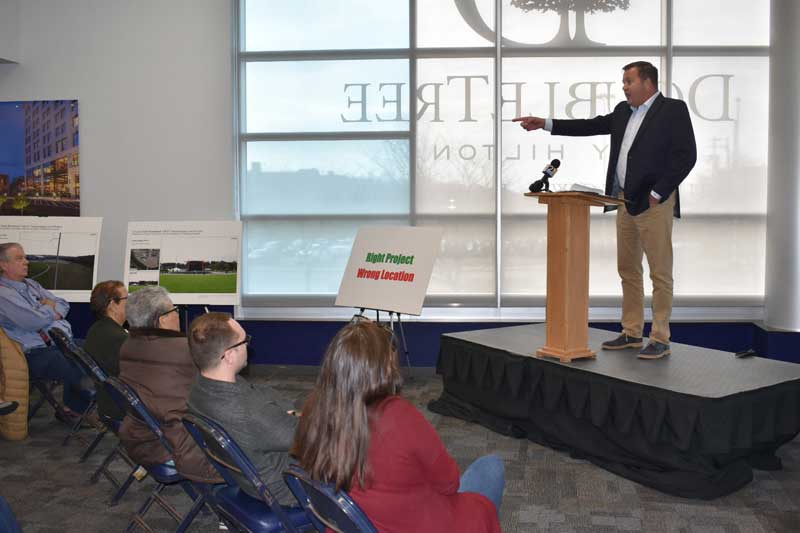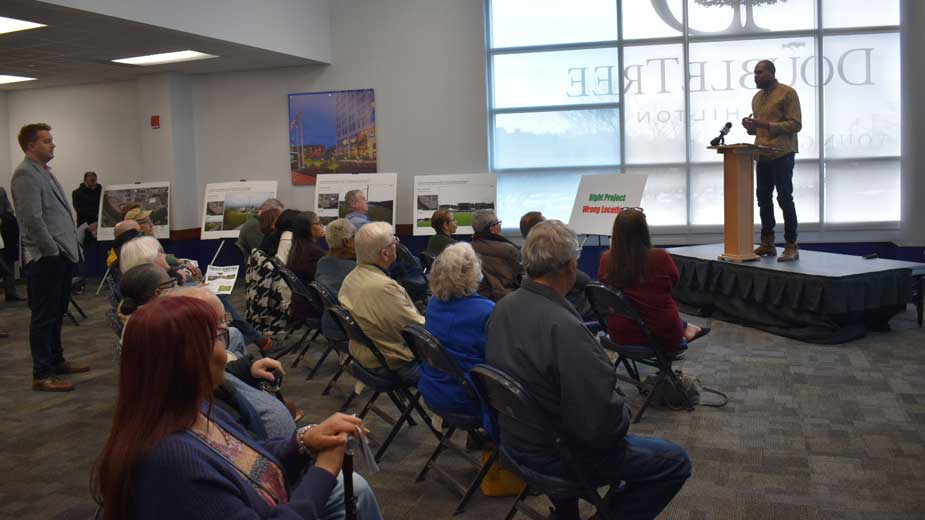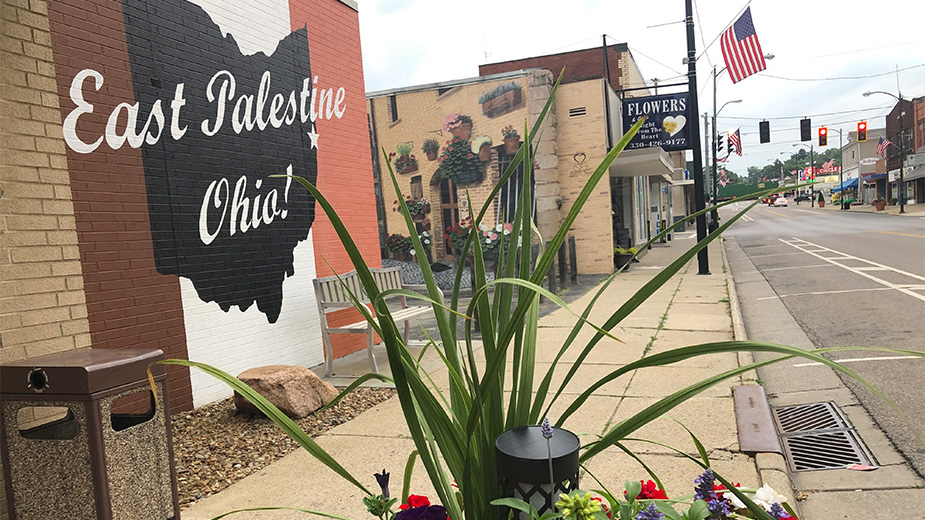‘Right Project, Wrong Location’: City Stakeholders Oppose Proposed Power Line
YOUNGSTOWN, Ohio — Downtown stakeholders voiced firm opposition Wednesday to a proposal by FirstEnergy to run a high-tension power line and towers along the Mahoning River, near where the city and community organizations have invested million of dollars on riverfront development.
About 80 representatives of the city, downtown businesses, institutions, community groups and others attended the meeting, held in the community room of the Covelli Centre, one of the riverfront assets opponents of the FirstEnergy plan say will be affected by it.
“We wanted to provide a chance for the community to have a voice,” said Adam Lee, Youngstown CityScape program director.
Some of those voices were more blunt than others.
“I’m sick of these entities and big corporations coming into our city and just taking a crap over us and leaving,” First Ward Councilman Julius Oliver said. “It’s amazing to me that [FirstEnergy subsidiary] Ohio Edison wants us to be concerned about their investment, whether they should bury the lines or put these ugly power lines up because burying them would cost too much. But you want to come in here and take a crap on our investment.”
The Ohio Power Siting Board is considering a request by a FirstEnergy subsidiary to erect an approximately six-mile, above-ground transmission line that would connect the utility’s Riverbend and Lincoln Park substations. The route along the Mahoning River would run near the city-owned Covelli Centre, Youngstown Foundation Amphitheater and Wean Park.
Erection of the towers and power line could begin later this year if approved by the state, FirstEnergy spokeswoman Brittany Al Dawood said in January. The 138-kilovolt line is needed to improve reliability for downtown and surrounding neighborhoods, she said.
“These improvements will not only help reduce outages, but also increase capacity to support future economic growth in the area,” Al Dawood said in an email Wednesday evening . “After an extensive routing study, this route was preferred for minimizing the impact on the environment and developed areas while still enhancing reliability for downtown and surrounding wards.”
The turnout at the meeting included representatives of the city, Eastgate Regional Council of Governments, Youngstown CityScape, Mahoning Valley Land Bank, Mahoning Valley Historical Society, downtown landlord Ohio One Corp. and America Makes, as well as residents of downtown and surrounding neighborhoods.
Those in attendance were encouraged to sign postcards in opposition to the project that would be mailed to the power siting board in Columbus.
Thousands of people are coming downtown to attend events now, said Oliver, who recently built a house on West Woodland Avenue overlooking downtown. Whereas people were reaching out to him daily about making similar neighborhood investments, now they are concerned that people won’t be interested because they “don’t want to look at ugly power lines out their window” or concerned that their property could be taken by eminent domain, he said.
While Oliver addressed the millions invested by the city and its partners in the Covelli Centre and neighboring properties, Derrick McDowell, founder of the Youngstown Flea and community engagement and inclusion coordinator for the Youngstown Foundation Amphitheatre and Raymond John Wean Foundation Park, took aim at FirstEnergy’s willingness to spend on politicians.
“I won’t mince words. FirstEnergy invested $60 million to try and bribe politicians to get themselves a billion-dollar bailout on the backs of your bill,” he said.
To those who argue that “bigger problems” need to be addressed, McDowell pointed out that infrastructure since the 1950s and ’60s has been used to impede progress and create borders.
“What I’m trying to get us all to see is that these small things, they are the big things. These are the things that will impede our access to progress on our riverfront,” he said. “They will impede access for my business that sits right around the corner … the investment I’ve made and so many others have made in this community.”

The “gazillion renderings” the city went through from architectural firms to develop plans for the arena and amphitheater “look nothing like that rendering you’re seeing today,” with power lines in the background, said Eric Ryan, president of JAC Management Group, which manages both of the facilities for the city.
“It is the right project in the wrong location,” Ryan said, echoing a sentiment frequently expressed during the meeting. In addition to voicing concerns about the aesthetic impact, he said he has not received a response to questions regarding potential electromagnetic interference. Talent also might be discouraged from booking shows at the venues.
“It’s going to be catastrophic to our business,” as well as for downtown businesses that benefit when patrons come to the venues for shows, he warned. According to the state of Ohio, for every ticket sold at such facilities, patrons spend $31 outside the venue.
“They dine in our restaurants, they fill their cars with gas, they may need something at a pharmacy or a store,” said Linda Macala, executive director of the Mahoning County Convention and Visitor’s Bureau. “Hopefully they spend the night [in a county hotel] because that’s how we’re funded.”
In 2019, the most recent year for which data is available, the state tourism office reported that the tourism and hospitality industry generated $561.7 million in Mahoning County, Macala said.
“People think this is a small thing. It’s a big thing,” she asserted. “You don’t realize how much visitor spending generates in economic development in Mahoning County.”
Jim Ambrose, a local point of contact for Desmone, the Pittsburgh architectural firm the city is working with to redevelop and sell 20 Federal Place, cautioned the transmission line plan could jeopardize those redevelopment efforts.
“It’s a $60 million project that we’re trying to bring to the city of Youngstown, and the No. 1 way to kill real estate investment, especially in and emerging market like this, is to cut off waterfront access,” he warned.
Youngstown Law Director Jeff Limbian offered assurances that the city was “absolutely against this” and had the back of the project’s opponents. Mayor Jamael Tito Brown, who was not at the meeting because he was out of town Wednesday, previously submitted written testimony to the power siting board expressing his opposition to the FirstEnergy proposal, he said
Limbian acknowledged that FirstEnergy’s proposal represented “an economic issue” for the company, which asserts the need for the power lines is to provide better service to the community.
“We may not like it, we may not agree with it and we may oppose it and ultimately, hopefully, strike down. But I just wanted you to know that that’s the genesis of this project,” he said. The mayor’s hope is that “discussions and communication will carry the day” before any court action that might be taken to oppose a decision by the board.
“Anytime there are decisions made, there’s always an appeal process or a way to challenge it if necessary,” Limbian said.
Zach Felger of Youngstown, a member of Friends of the Mahoning River, warned of potential environmental consequences from burying power lines, especially if it is done along the Mahoning River. Those include release of sulfur hexafluoride, which he said is a greenhouse chemical that gets up into the atmosphere and causes cancer, and the “environmental disturbances” that take place when transmission lines are buried.
“You are obviously carrying out sediments, which would then transfer into the river and be detrimental to the aquatic organisms,” he said.
Following the meeting, others expressed their opposition to the plan, including Ohio One Corp.’s president, Rich Mills, and Hunter Morrison, an urban planning consultant working for the city,
“I can’t believe that Ohio Edison would even propose that,” Mills said. “It’s ridiculous that they would even consider putting those poles there.”
Morrison said the proposal “runs counter” to the city’s efforts to create a park along the river.
“There are obviously aesthetic issues. There may be some health risk issues. But it really gets to whether FirstEnergy understands what downtown is becoming,” he said. Most wiring downtown and around the Youngstown State University campus is buried, and he urged the company to work with the community to achieve “a better outcome.”
FirstEnergy is “committed to working with city leaders” as the project moves forward, its spokesman, Dawood, said Wednesday.
“Right now, the decision rests with the Ohio Power Siting Board,” she said. She did not have a timeline for when the board would make its decision.
Pictured: Derrick McDowell argues the lines would impede the city’s access to progress on the riverfront.
Copyright 2024 The Business Journal, Youngstown, Ohio.



